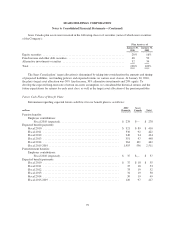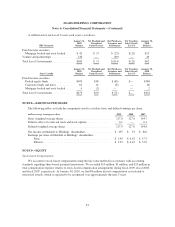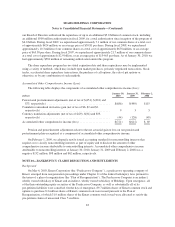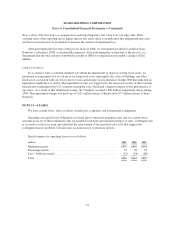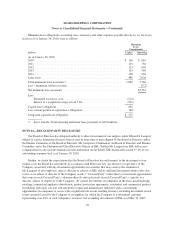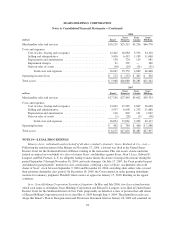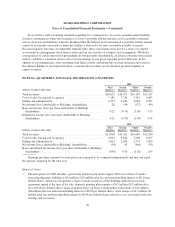Sears 2009 Annual Report Download - page 88
Download and view the complete annual report
Please find page 88 of the 2009 Sears annual report below. You can navigate through the pages in the report by either clicking on the pages listed below, or by using the keyword search tool below to find specific information within the annual report.SEARS HOLDINGS CORPORATION
Notes to Consolidated Financial Statements—(Continued)
penalties recognized on our consolidated balance sheet was $71 million ($46 million net of federal benefit). The
total amount of net interest income recognized in our consolidated statement of income for fiscal 2009 was
$11 million.
We file income tax returns in both the United States and various foreign jurisdictions. The U.S. Internal
Revenue Service (“IRS”) is currently auditing the Holdings’ federal income tax returns for the fiscal years 2006
and 2007. The IRS has completed its examination of Sears’ federal income tax returns for the fiscal years 2002,
2003, 2004, and 2005 and Holdings’ federal income tax return for the fiscal year 2005. We have resolved with
the IRS all matters arising from these exams. In addition, Holdings and Sears are under examination by various
state, local and foreign income tax jurisdictions for the fiscal years 2001-2007, and Kmart is under examination
by such jurisdictions for the fiscal years 2003-2007.
NOTE 12—REAL ESTATE TRANSACTIONS
Gain on Sale of Assets
We recognized $74 million, $51 million, and $38 million in gains on sales of assets during fiscal 2009,
fiscal 2008, and fiscal 2007, respectively. These gains were primarily a function of several large real estate
transactions. During fiscal 2009, the gain on sales of assets included a $44 million gain recognized by Sears
Canada on the sale of its former headquarters. During fiscal 2008, the gain on sale of assets included a $32
million pre-tax gain recognized on the sale of Sears Canada’s Calgary downtown full-line store. During fiscal
2007, the gain on sale of assets included a $21 million pre-tax gain on the sale of our Sears fashion center in Los
Angeles.
In August 2007, Sears Canada sold its headquarters office building and adjacent land in Toronto, Ontario for
proceeds of $81 million Canadian, net of closing costs. Sears Canada leased back the property under a leaseback
agreement through March 2009, at which time it finished its relocation of all head office operations to previously
underutilized space in the Toronto Eaton Centre, Ontario. The carrying value of the property was approximately
$35 million as of February 2, 2008. Given the terms of the leaseback, for accounting purposes, the excess of
proceeds received over the carrying value of the associated property was deferred, and the resulting gain was
recognized in fiscal 2009 given that Sears Canada no longer occupied the associated property.
We classify a portion of our property as held for sale when criteria set out under accounting standards
governing the disposal of long-lived assets have been met. Property held for sale at January 30, 2010 and
January 31, 2009 totaled $38 million and $58 million, respectively.
Property Acquisitions
During fiscal 2008 and fiscal 2007, we purchased 9 and 28 previously leased operating properties for
$22 million and $109 million, respectively. During fiscal 2009, we did not purchase any previously leased
operating properties. In the normal course of business, we consider opportunities to purchase leased operating
properties, as well as offers to sell owned, or assign leased, operating and non-operating properties. These
transactions may, individually or in the aggregate, result in material proceeds or outlays of cash. In addition, we
review leases that will expire in the short-term in order to determine the appropriate action to take with respect to
them.
88



